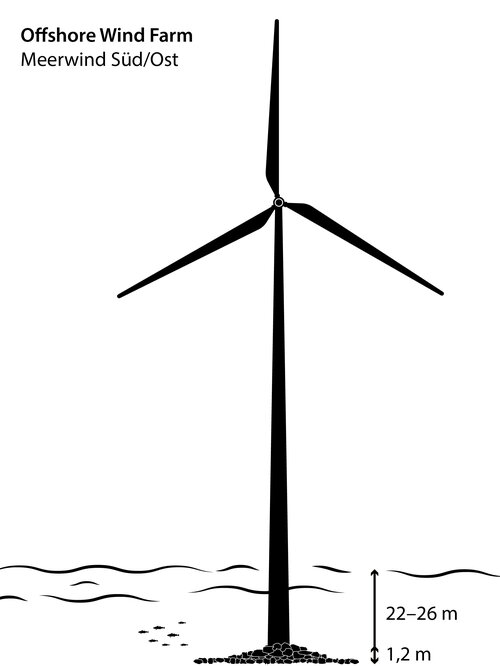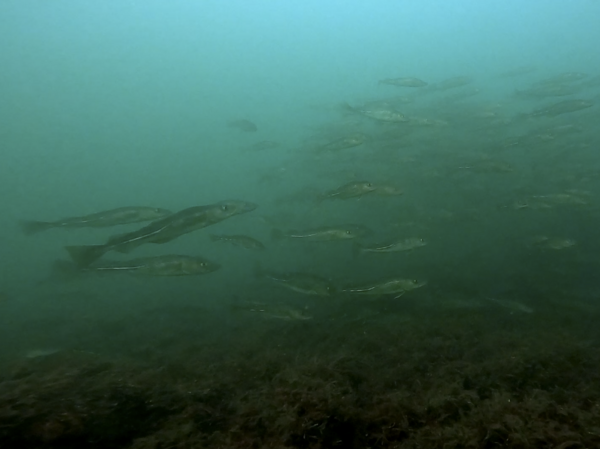Expertise
Offshore wind farm as a cod refuge
Vanessa Stelzenmüller, Karl-Michael Werner, Holger Haslob | 02.11.2023
A pilot study with a new monitoring approach in the German Bight confirms the ecological importance of offshore wind farms as a potential refuge and food source for marine life: Rock piles at the base of wind turbines function as artificial reefs and have a positive effect on species such as cod, which lives partly on the ground. Could some offshore wind farms soon function also as refuge?
Cod (Gadhus morhua) is widespread throughout the North Atlantic including the North and Baltic Seas and was an important target species for German fisheries. Due to over-intensive fishing, cod has declined sharply since the 2000s, particularly in the southern North Sea and the western Baltic Sea. Global warming caused by climate change is also preventing stocks from recovering. It is of great importance for fisheries and ecosystems in the North Sea and Baltic Sea that this species recovers. Wind farms could play a role here since fishing with bottom contacting gears is excluded from those areas that are partly located in the cod's range.
Wind farms in which the wind turbines on the seafloor are reinforced by rock piles are particularly interesting. In contrast to the intensively fished, sandy bottoms in the North Sea, wind farms of this type offer structurally rich retreats. These new habitats offer a rich diet comprising mussels, crustaceans and smaller fish. Scientific studies (e.g. Reubens et al. 2014a) confirm that cod are also among the fish species that seek shelter and feed at the rocky turbine piles in wind farms.

How do cod use wind farms?
In order to answer this question more precisely, researchers from the Thünen Institute of Sea Fisheries have developed and implemented a new monitoring concept using the offshore wind farm Meerwind Süd/Ost (OWF) in the German Bight as an example (Gimpel et al. 2023). For the first time, they compared cod catches inside and outside the wind farm from the summer and winter of 2019 and 2020.
The fishing methods differed considerably due to the safety requirements: in the wind farm, the researchers fished for adult animals within a radius of around ten meters around the piers of the wind turbines. Catches from regular fishing surveys were used as reference samples from outside the wind farm: the International Bottom Trawl Survey (IBTS) and the German Small-Scale Bottom Trawl Survey (GSBTS), which involve fishing with bottom trawls.
For the first time, the scientists also searched for cod eggs inside and outside the wind farm during the spawning season. They wanted to find out whether cod uses the wind farm as a spawning area. The way in which the data was evaluated was also new: the research team genetically examined the fish eggs and analyzed them using a drift model (Pellets 2D developed at Hereon). The model simulates the drift of the fish eggs in the ocean current. As a result, the scientists can say relatively precisely when and where the cod eggs were produced.
In addition to the age, size and general condition of the animals, the origin of their food was also determined. To do this, the stomach contents were analyzed using nitrogen and carbon isotopes. This involves breaking down the food remains into their elementary particles. Depending on the location or region, these have different chemical properties and thus a local "fingerprint".
Permanent guest in summer, spawning area in winter
The analysis of a total of 217 fish (134 inside and 54 outside the wind farm) and 214 fish eggs showed that the animals caught were larger and more numerous inside the wind farm than outside. The new method combination of genetics and drift simulation proved for the first time that every tenth egg had its origin in the wind farm. The stomach contents revealed a more diverse diet in the wind farm than outside: The cod's diet consisted mainly of porcelain crabs and butterfish, which prefer hard substrates such as the turbine piles as their habitat. The additional analysis of the origin of the stomach contents showed for the first time that the cod used the area around the wind turbine piles in the wind farm as a long-term food source, especially in summer.
Utilization and protection at the same time?
As the study is limited to just one wind farm, the results do not allow for general conclusions at population level. However, the fact that the cod stay there permanently and even spawn underlines the ecological value of wind farms with rocky wind turbine piles in the southern North Sea.
In addition, the diversity of the data analysis shows a new way to answer monitoring questions about the ecological effects of wind farms in a more targeted manner - despite the limited study area, the comparatively small sample and different fishing methods.
If further studies confirm the positive effects of wind farms with an artificial reef effect, the protection factor of these areas should be incorporated into the management concepts for marine spatial planning. In the long term, this could have a positive effect on the recovery of the cod population and thus also benefit the fishery.
Publications
- 0
Gimpel A, Werner K-M, Bockelmann F-D, Haslob H, Kloppmann MHF, Schaber M, Stelzenmüller V (2023) Ecological effects of offshore wind farms on Atlantic cod (Gadus morhua) in the southern North Sea. Sci Total Environ 878:162902, DOI:10.1016/j.scitotenv.2023.162902
- 1
Gimpel A, Stelzenmüller V, Haslob H, Berkenhagen J, Schupp MF, Krause G, Buck BH (2020) Offshore-Windparks: Chance für Fischerei und Naturschutz. Braunschweig: Johann Heinrich von Thünen-Institut, 6 p, Thünen à la carte 7, DOI:10.3220/CA1580724472000







